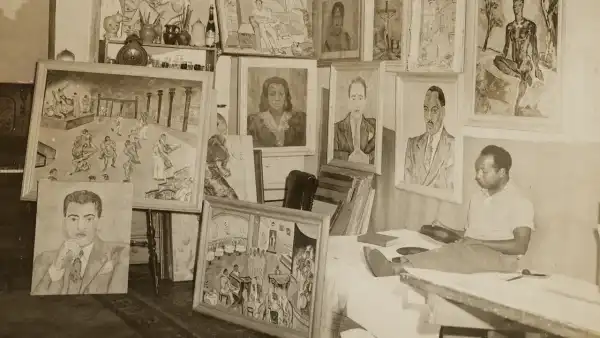
Save this storySave this storySave this storySave this story
There’s so much going on in “In the Environment of Life: The Drawings of Beauford Delaney” (at the Drawing Center through September 14) that you might come away wishing it could have been more compact. There are fewer of Delaney’s mediocre works, less archival material, and less effort to establish him as an important American artist. Although he was important—unique in his time and place—he has rarely been presented in a way that deepens understanding of his art. Curators and writers tend to romanticize his past, focusing on his difficult beginnings in Tennessee at the turn of the twentieth century and his fortunes as a friend of cultural icons like Georgia O’Keeffe and James Baldwin, without facilitating critical distinctions between the work that deserves attention and that is best left aside.
In “In the Living Environment,” Rebecca DiGiovanna and Laura Hoptman, respectively the Drawing Center’s assistant curator and executive director, make a compelling case for Delaney, but they are troubled by the Drawing Center’s focus on drawings, failing to fully explore the relationships between these largely lesser works and Delaney’s more expressive paintings. To compensate, they present more drawings than they should, and in greater numbers than the space allows, making the show feel crowded. Stephen Weeks, in his 2020 Knoxville Museum of Art show, “Beauford Delaney and James Baldwin: Through an Unusual Door,” understood that Delaney’s work needed more space around it. His surfaces are rich with texture and vibrancy. If the works are placed too close together, the eye quickly tires, creating the impression that Delaney’s world is shrinking around you, as his intensity closes you off from yourself. Of course, DiGiovanna and Hoptman don’t want you to feel isolated, and you’ll be hard-pressed to miss their sincere intentions in inviting you to enjoy the seventy-six drawings and five paintings they’ve collected, along with some interesting ephemera—newspaper clippings and personal notes. Hoptman’s goal, which she makes clear in the catalogue, is to free Delaney from his biography, from his fame by association, and to focus on how he became increasingly free as an artist, increasingly coming into his own.

“Central Park,” 1950. Illustration by Beauford Delaney / © Estate of Beauford Delaney, courtesy of Derek L. Spratley, Esquire / Courtesy of Michael Rosenfeld Gallery
Delaney’s style, or styles, were developed through a long apprenticeship that can be seen as a novelization of his tortured life—Van Gogh as reimagined by Irving Stone. Like Van Gogh himself, Delaney suffered from mental illness and sometimes heard voices that told him he was inferior because of his race or insulted him for his sexuality. Delaney’s talent for drawing emerged when, as a teenager in Knoxville—where his mother worked as a maid and did laundry to support the family—he worked for a time in a shoe repair shop. One day, he accidentally left his sketchbook behind at work. Impressed by what he saw, Delaney’s boss introduced him to a local artist, a white, upper-class painter named Lloyd Branson, who offered him drawing lessons in exchange for helping out in his studio. Eventually, Branson
Sourse: newyorker.com






